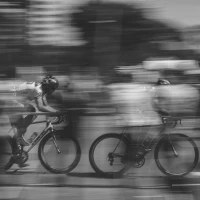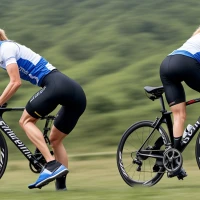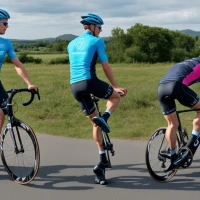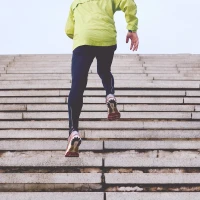Cycling, a low-impact aerobic exercise, is not only a green mode of transportation but also a fantastic way to improve overall health, fine-tune endurance, and sculpt a strong and resilient body. Understanding what muscles cycling works is fundamental to maximizing the benefits of this ubiquitous activity. Whether you’re an experienced cyclist, commuting rider, or fitness enthusiast longing for a change in routine, you’ll find that the myriad of muscles energized by cycling contributes to a well-rounded physical condition, enhancing your vitality and well-being.
Cycling’s popularity continues to surge as a versatile workout due to its accessibility and the breadth of muscular benefits it offers. Each pedal stroke propels you not only towards your destination but also towards a greater state of fitness. This in-depth exploration will provide you with insights into how cycling can transform your muscle strength, endurance, and tone.
The Powerhouse: Muscular Groups Activated by Cycling
Cycling is not just an excellent cardiovascular activity; it’s a comprehensive workout that involves several major muscle groups. As you engage in cycling workouts, you are essentially inviting every pedal push to sculpt your lower body, core, and even upper body muscles to various extents.
The Lower Body: Cycling’s Primary Musculature
- Quadriceps: These are the key muscles at the front of your thighs and are the primary drivers during the pedal downstroke.
- Hamstrings: Located at the back of your thighs, the hamstrings work in tandem with the quadriceps and are particularly active during the upstroke.
- Calves: Your calf muscles, including the gastrocnemius and soleus, push down through the balls of your feet to aid in propelling the bike forward.
- Gluteal Muscle Group: Comprising the gluteus maximus, medius, and minimus, these muscles are pivotal for hip extension and stability while riding.
- Hip Flexors: They play a crucial role in the upward phase of the pedaling cycle.
Core Stability: The Unseen Hero of Cycling
- Abdominal Muscles: While not as prominently worked as the lower body, the core muscles including the rectus abdominis and obliques, help to maintain stability and posture on the bike.
- Lower Back Muscles: The erector spinae muscles support the spine, aiding in the cyclist’s posture and power transfer throughout the ride.
Upper Body: Supporting Role in Cycling Dynamics
- Shoulder Muscles: Especially during intense or off-road rides, the deltoids are engaged to handle the bike and maintain balance.
- Arm Muscles: Triceps and biceps support the upper body, particularly when standing up on the pedals or during sprints.
- Forearm and Hand Muscles: Gripping the handlebars engages these muscles, critical for controlling the bike.
Tailoring Your Ride: Cycling Techniques to Target Muscles
Cycling can be adjusted to target specific muscle groups or to achieve varied fitness goals. Whether you’re aiming for leg strength, improved stamina, or increased aerobic capacity, the way you cycle can have pronounced effects on what muscles are worked.
High Gear vs Low Gear: Quadriceps vs Hamstrings
If you’re looking to emphasize different muscles during your ride, adjusting your gear is an effective strategy. A higher gear requires more force in each pedal stroke, predominantly engaging your quadriceps. Conversely, a lower gear with higher cadence will shift the focus to your hamstrings and calf muscles.
Climb Steep Hills: Maximizing Glute Workout
To give your glutes an intense workout, find a challenging incline. As you tackle the ascent, your gluteal muscles will become powerhouse contributors, driving you upwards against gravity.
Sprinting and Standing: Activate Your Upper Body
Engage your upper body muscles by sprinting or standing on the pedals. This action not only helps to boost your speed but also recruits your deltoids, arms, and even pectoral muscles into the workout.
Long Distance Endurance Rides: Building Core and Leg Endurance
Embarking on longer rides, you not only challenge your leg muscles but also your core endurance. Sustaining proper posture over an extended period, you fortify your abdominal and lower back muscles.
Optimizing Cycling Performance: Strength Workouts for Key Muscles
While cycling itself is a fantastic workout, cross-training with focused strength exercises can lead to even better performance and muscular balance. A strategic combination of cycling and strength training can help to ensure all the key muscles are well-developed and injury risks are minimized.
Quadriceps: Squats and Leg Presses
Incorporate squats and leg presses into your routine to build a strong foundation for powerful pedal strokes.
Hamstrings and Glutes: Deadlifts and Bridges
Training with deadlifts and hip bridges can enhance the strength and coordination of your hamstrings and glutes, essential for efficient cycling.
Calves: Calf Raises
Strengthen your calf muscles with calf raise exercises to improve the pushing phase of your pedal cycle.
Core Muscles: Planks and Crunches
Engage your core with planks and crunches to maintain a solid and stable upper body position on long rides.
Upper Body: Push-ups and Pull-ups
Balance your physique and aid in bike handling by incorporating push-ups and pull-ups to develop your upper body muscles.
Injury Prevention and Flexibility: Keeping Your Muscles Cycling-Ready
The repetitive nature of cycling can, over time, lead to muscle tightness or imbalance if not addressed. Thus, balancing your cycling routine with flexibility exercises and proper form is crucial in avoiding injuries.
Stretching: Essential for Muscle Recovery
Implementing a routine of dynamic stretching before rides and static stretching post-ride is essential in maintaining flexibility and reducing the risk of muscle strains.
Yoga and Pilates: Core Strength and Flexibility
Yoga and Pilates can be excellent adjuncts to cycling, offering improvements in both core strength and muscular flexibility.
Proper Bike Fit: Reducing Strain on Muscles
Ensuring your bike is properly fitted to your body is crucial. A poorly fitted bike can cause unnecessary strain on various muscles and joints, leading to discomfort and potential injury.
Nutrition and Hydration: Fueling the Muscular Engine
Proper nutrition and hydration play a pivotal role in maximizing the benefits of cycling on your muscles. Feeding your body with the right nutrients ensures recovery and growth, while sufficient hydration prevents cramping and fatigue.
Carbohydrates: The Cyclist’s Main Fuel
Prioritize carbohydrates in your diet to supply the energy needed for your cycling workouts, ensuring your muscles have the glycogen stores required for endurance.
Protein: Building and Repairing Muscles
Include high-quality protein in your diet to aid in muscle repair and growth post-exercise, particularly important after intense cycling sessions.
Electrolytes: Maintaining Muscle Function
Replenishing electrolytes through sports drinks or electrolyte tablets can help maintain muscle function and prevent cramps, especially during longer rides in hot weather.
Conclusion: Reap the Rewards of Regular Cycling
Understanding what muscles cycling works is more than just an academic exercise; it’s a way to consciously engage in a workout that offers holistic benefits to the body. Regular cycling can sculpt a toned, more resilient musculature, support heart health, and uplift mental well-being. Embrace this two-wheeled journey and pedal your way to peak fitness, knowing that with each stride, you’re energizing a symphony of muscles that underpin your strength, endurance, and mobility. So grab your helmet, clip in your shoes, and let pedal power lead the way to a stronger, healthier you.










